PRIMITIVE REFLEXES1.ppt
- Количество слайдов: 36
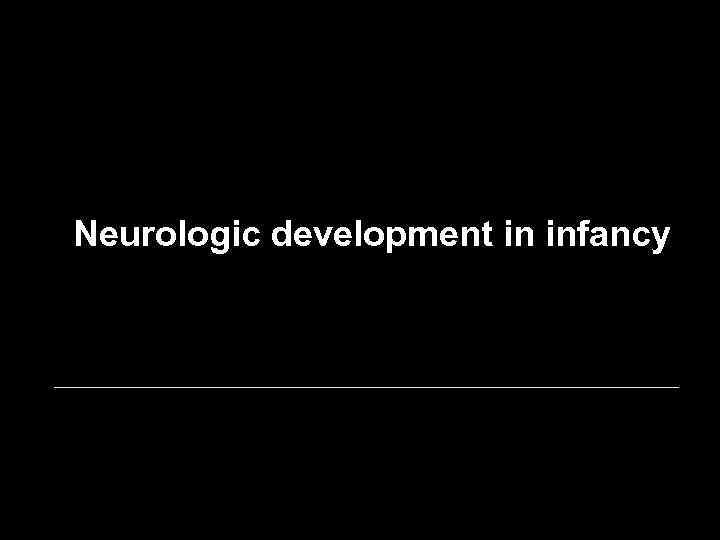 Neurologic development in infancy
Neurologic development in infancy
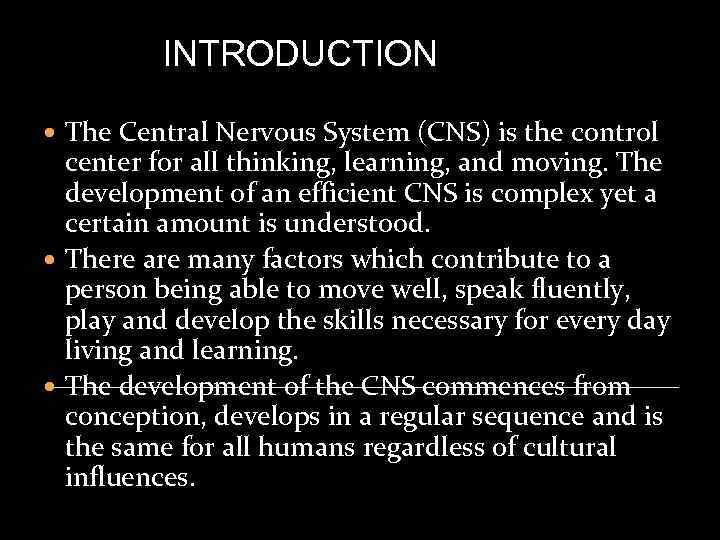 INTRODUCTION The Central Nervous System (CNS) is the control center for all thinking, learning, and moving. The development of an efficient CNS is complex yet a certain amount is understood. There are many factors which contribute to a person being able to move well, speak fluently, play and develop the skills necessary for every day living and learning. The development of the CNS commences from conception, develops in a regular sequence and is the same for all humans regardless of cultural influences.
INTRODUCTION The Central Nervous System (CNS) is the control center for all thinking, learning, and moving. The development of an efficient CNS is complex yet a certain amount is understood. There are many factors which contribute to a person being able to move well, speak fluently, play and develop the skills necessary for every day living and learning. The development of the CNS commences from conception, develops in a regular sequence and is the same for all humans regardless of cultural influences.
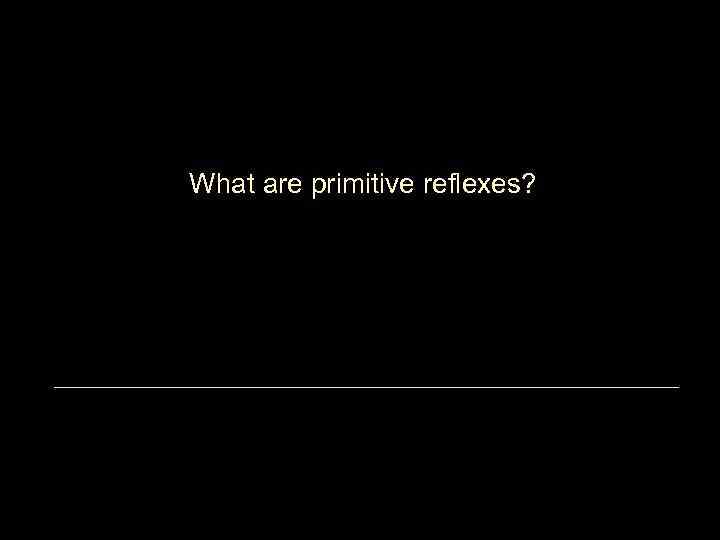 What are primitive reflexes?
What are primitive reflexes?
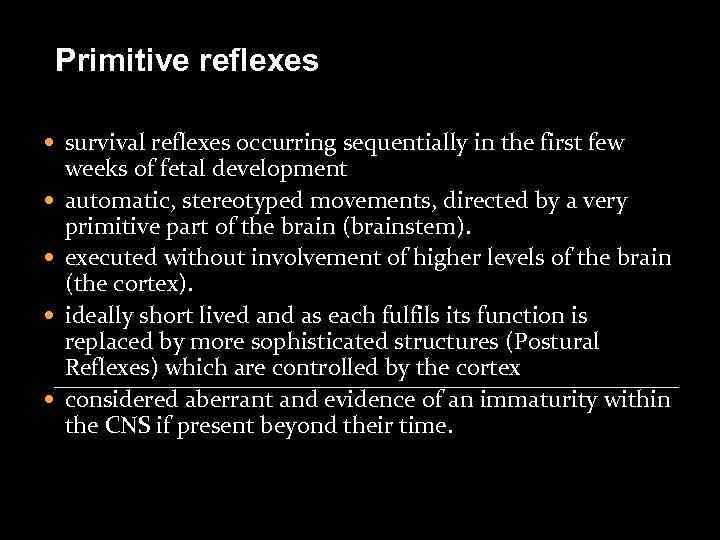 Primitive reflexes survival reflexes occurring sequentially in the first few weeks of fetal development automatic, stereotyped movements, directed by a very primitive part of the brain (brainstem). executed without involvement of higher levels of the brain (the cortex). ideally short lived and as each fulfils its function is replaced by more sophisticated structures (Postural Reflexes) which are controlled by the cortex considered aberrant and evidence of an immaturity within the CNS if present beyond their time.
Primitive reflexes survival reflexes occurring sequentially in the first few weeks of fetal development automatic, stereotyped movements, directed by a very primitive part of the brain (brainstem). executed without involvement of higher levels of the brain (the cortex). ideally short lived and as each fulfils its function is replaced by more sophisticated structures (Postural Reflexes) which are controlled by the cortex considered aberrant and evidence of an immaturity within the CNS if present beyond their time.
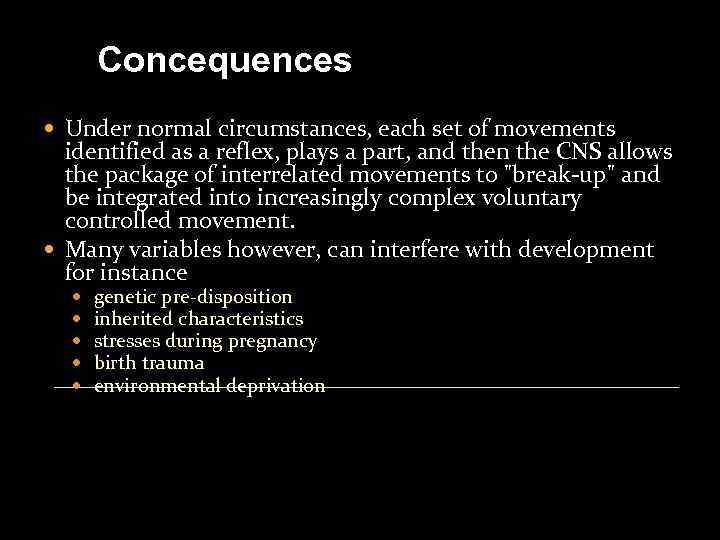 Concequences Under normal circumstances, each set of movements identified as a reflex, plays a part, and then the CNS allows the package of interrelated movements to "break-up" and be integrated into increasingly complex voluntary controlled movement. Many variables however, can interfere with development for instance genetic pre-disposition inherited characteristics stresses during pregnancy birth trauma environmental deprivation
Concequences Under normal circumstances, each set of movements identified as a reflex, plays a part, and then the CNS allows the package of interrelated movements to "break-up" and be integrated into increasingly complex voluntary controlled movement. Many variables however, can interfere with development for instance genetic pre-disposition inherited characteristics stresses during pregnancy birth trauma environmental deprivation
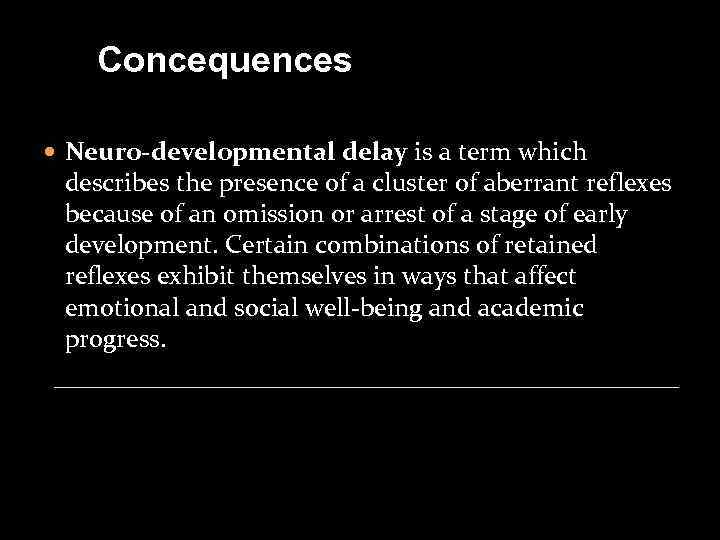 Concequences Neuro-developmental delay is a term which describes the presence of a cluster of aberrant reflexes because of an omission or arrest of a stage of early development. Certain combinations of retained reflexes exhibit themselves in ways that affect emotional and social well-being and academic progress.
Concequences Neuro-developmental delay is a term which describes the presence of a cluster of aberrant reflexes because of an omission or arrest of a stage of early development. Certain combinations of retained reflexes exhibit themselves in ways that affect emotional and social well-being and academic progress.
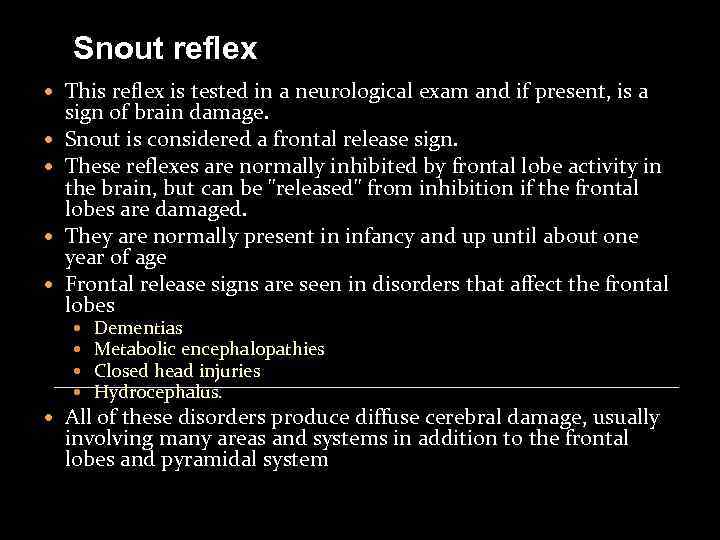 Snout reflex This reflex is tested in a neurological exam and if present, is a sign of brain damage. Snout is considered a frontal release sign. These reflexes are normally inhibited by frontal lobe activity in the brain, but can be "released" from inhibition if the frontal lobes are damaged. They are normally present in infancy and up until about one year of age Frontal release signs are seen in disorders that affect the frontal lobes Dementias Metabolic encephalopathies Closed head injuries Hydrocephalus. All of these disorders produce diffuse cerebral damage, usually involving many areas and systems in addition to the frontal lobes and pyramidal system
Snout reflex This reflex is tested in a neurological exam and if present, is a sign of brain damage. Snout is considered a frontal release sign. These reflexes are normally inhibited by frontal lobe activity in the brain, but can be "released" from inhibition if the frontal lobes are damaged. They are normally present in infancy and up until about one year of age Frontal release signs are seen in disorders that affect the frontal lobes Dementias Metabolic encephalopathies Closed head injuries Hydrocephalus. All of these disorders produce diffuse cerebral damage, usually involving many areas and systems in addition to the frontal lobes and pyramidal system
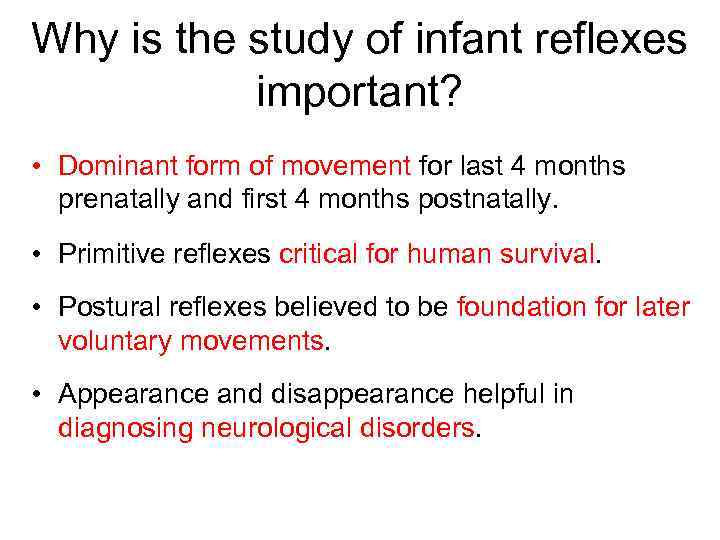 Why is the study of infant reflexes important? • Dominant form of movement for last 4 months prenatally and first 4 months postnatally. • Primitive reflexes critical for human survival. • Postural reflexes believed to be foundation for later voluntary movements. • Appearance and disappearance helpful in diagnosing neurological disorders.
Why is the study of infant reflexes important? • Dominant form of movement for last 4 months prenatally and first 4 months postnatally. • Primitive reflexes critical for human survival. • Postural reflexes believed to be foundation for later voluntary movements. • Appearance and disappearance helpful in diagnosing neurological disorders.
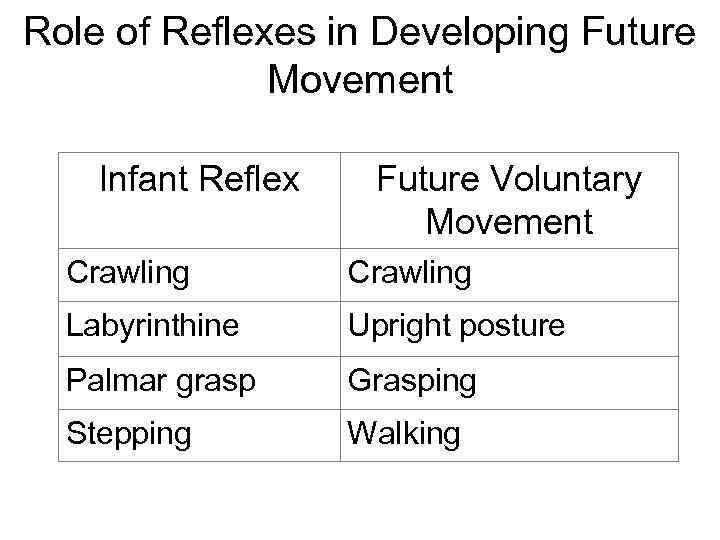 Role of Reflexes in Developing Future Movement Infant Reflex Future Voluntary Movement Crawling Labyrinthine Upright posture Palmar grasp Grasping Stepping Walking
Role of Reflexes in Developing Future Movement Infant Reflex Future Voluntary Movement Crawling Labyrinthine Upright posture Palmar grasp Grasping Stepping Walking
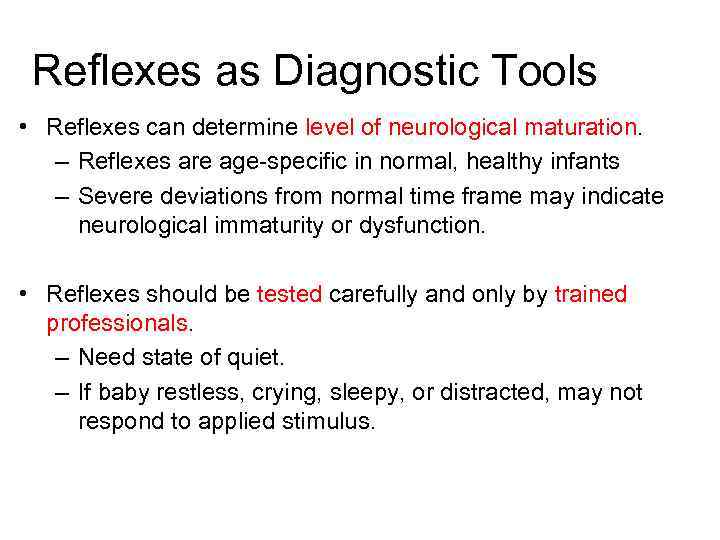 Reflexes as Diagnostic Tools • Reflexes can determine level of neurological maturation. – Reflexes are age-specific in normal, healthy infants – Severe deviations from normal time frame may indicate neurological immaturity or dysfunction. • Reflexes should be tested carefully and only by trained professionals. – Need state of quiet. – If baby restless, crying, sleepy, or distracted, may not respond to applied stimulus.
Reflexes as Diagnostic Tools • Reflexes can determine level of neurological maturation. – Reflexes are age-specific in normal, healthy infants – Severe deviations from normal time frame may indicate neurological immaturity or dysfunction. • Reflexes should be tested carefully and only by trained professionals. – Need state of quiet. – If baby restless, crying, sleepy, or distracted, may not respond to applied stimulus.
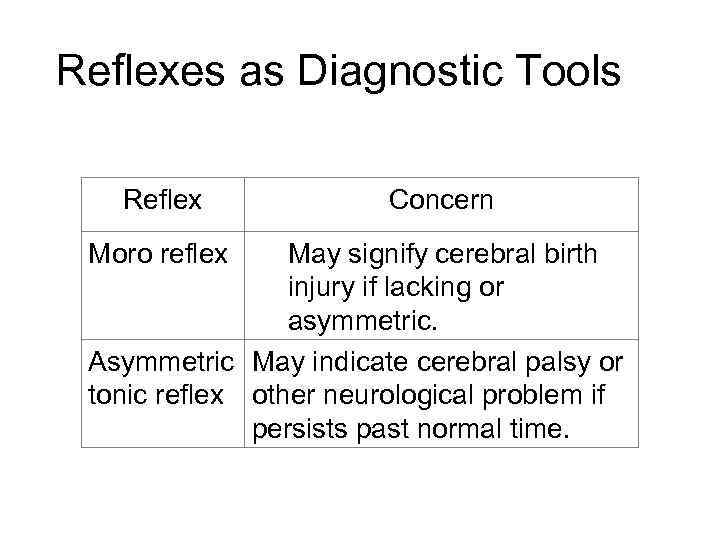 Reflexes as Diagnostic Tools Reflex Moro reflex Concern May signify cerebral birth injury if lacking or asymmetric. Asymmetric May indicate cerebral palsy or tonic reflex other neurological problem if persists past normal time.
Reflexes as Diagnostic Tools Reflex Moro reflex Concern May signify cerebral birth injury if lacking or asymmetric. Asymmetric May indicate cerebral palsy or tonic reflex other neurological problem if persists past normal time.
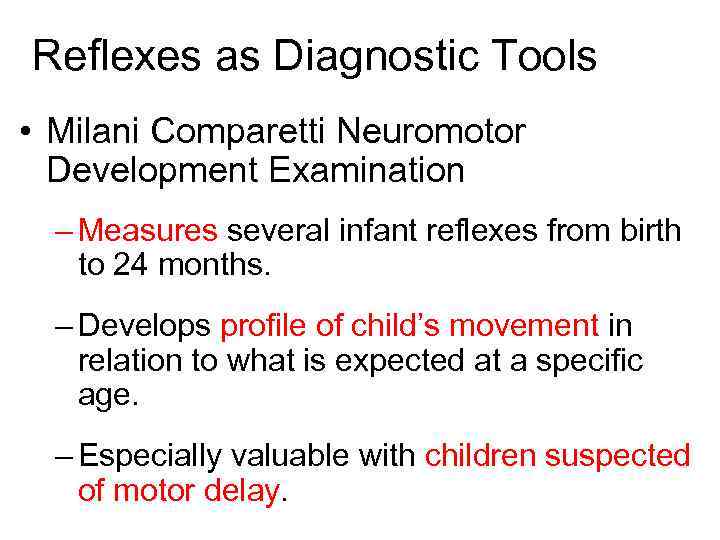 Reflexes as Diagnostic Tools • Milani Comparetti Neuromotor Development Examination – Measures several infant reflexes from birth to 24 months. – Develops profile of child’s movement in relation to what is expected at a specific age. – Especially valuable with children suspected of motor delay.
Reflexes as Diagnostic Tools • Milani Comparetti Neuromotor Development Examination – Measures several infant reflexes from birth to 24 months. – Develops profile of child’s movement in relation to what is expected at a specific age. – Especially valuable with children suspected of motor delay.
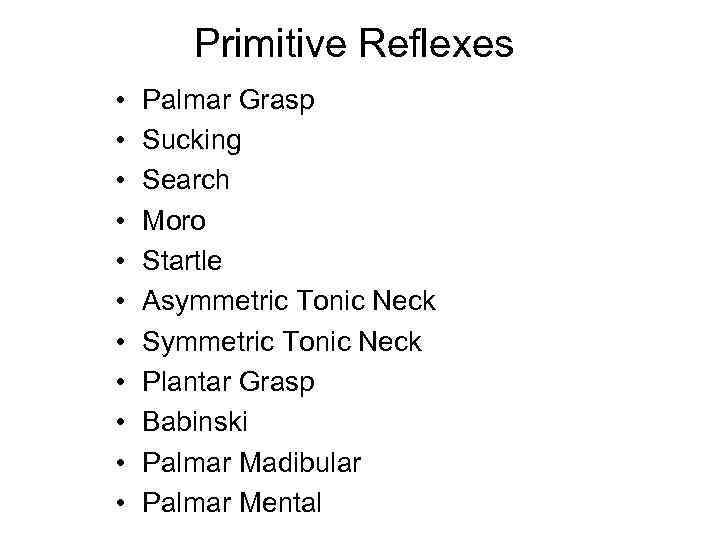 Primitive Reflexes • • • Palmar Grasp Sucking Search Moro Startle Asymmetric Tonic Neck Symmetric Tonic Neck Plantar Grasp Babinski Palmar Madibular Palmar Mental
Primitive Reflexes • • • Palmar Grasp Sucking Search Moro Startle Asymmetric Tonic Neck Symmetric Tonic Neck Plantar Grasp Babinski Palmar Madibular Palmar Mental
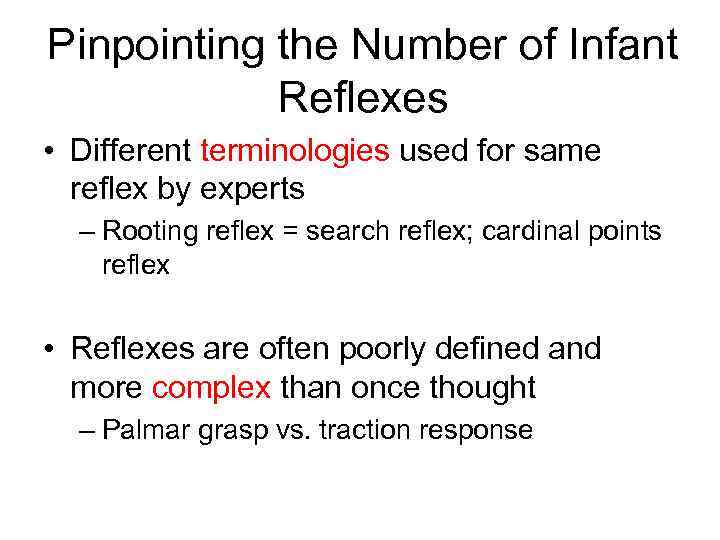 Pinpointing the Number of Infant Reflexes • Different terminologies used for same reflex by experts – Rooting reflex = search reflex; cardinal points reflex • Reflexes are often poorly defined and more complex than once thought – Palmar grasp vs. traction response
Pinpointing the Number of Infant Reflexes • Different terminologies used for same reflex by experts – Rooting reflex = search reflex; cardinal points reflex • Reflexes are often poorly defined and more complex than once thought – Palmar grasp vs. traction response
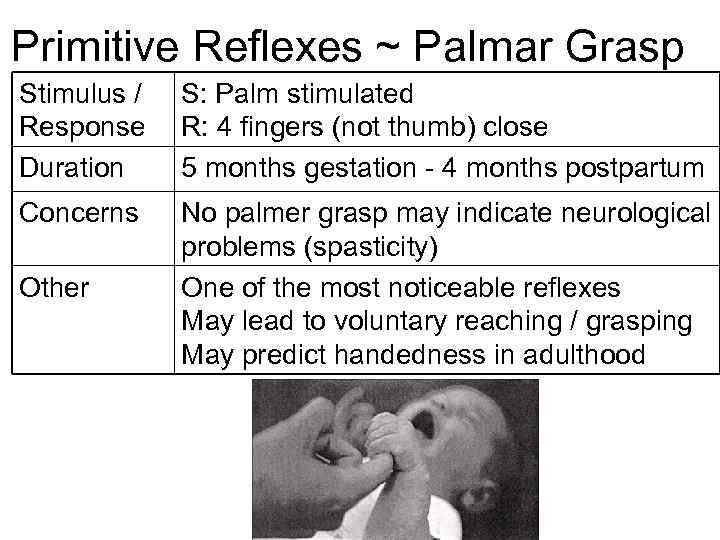 Primitive Reflexes ~ Palmar Grasp Stimulus / Response Duration S: Palm stimulated R: 4 fingers (not thumb) close 5 months gestation - 4 months postpartum Concerns No palmer grasp may indicate neurological problems (spasticity) One of the most noticeable reflexes May lead to voluntary reaching / grasping May predict handedness in adulthood Other
Primitive Reflexes ~ Palmar Grasp Stimulus / Response Duration S: Palm stimulated R: 4 fingers (not thumb) close 5 months gestation - 4 months postpartum Concerns No palmer grasp may indicate neurological problems (spasticity) One of the most noticeable reflexes May lead to voluntary reaching / grasping May predict handedness in adulthood Other
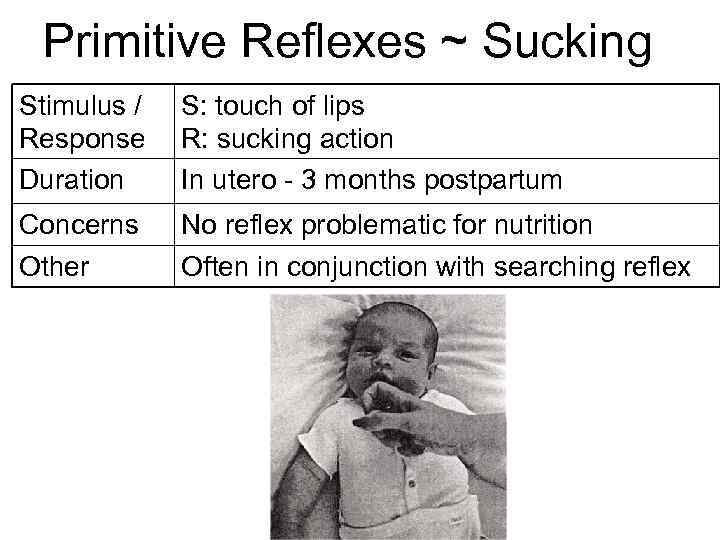 Primitive Reflexes ~ Sucking Stimulus / Response Duration S: touch of lips R: sucking action In utero - 3 months postpartum Concerns No reflex problematic for nutrition Other Often in conjunction with searching reflex
Primitive Reflexes ~ Sucking Stimulus / Response Duration S: touch of lips R: sucking action In utero - 3 months postpartum Concerns No reflex problematic for nutrition Other Often in conjunction with searching reflex
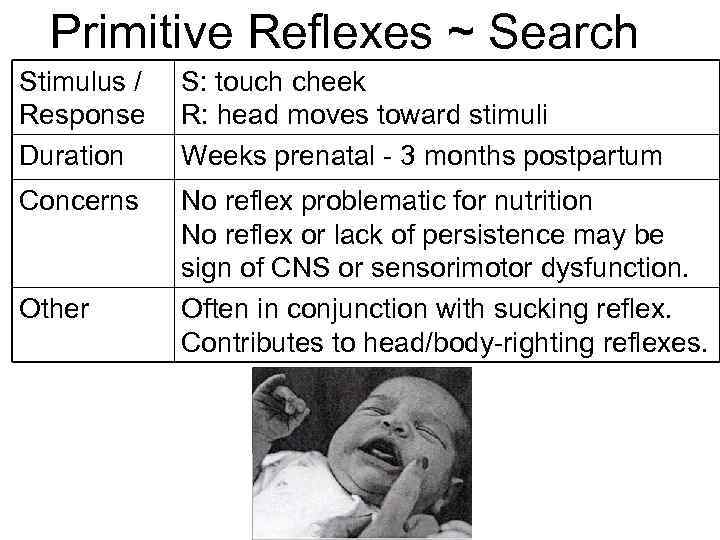 Primitive Reflexes ~ Search Stimulus / Response Duration S: touch cheek R: head moves toward stimuli Weeks prenatal - 3 months postpartum Concerns No reflex problematic for nutrition No reflex or lack of persistence may be sign of CNS or sensorimotor dysfunction. Often in conjunction with sucking reflex. Contributes to head/body-righting reflexes. Other
Primitive Reflexes ~ Search Stimulus / Response Duration S: touch cheek R: head moves toward stimuli Weeks prenatal - 3 months postpartum Concerns No reflex problematic for nutrition No reflex or lack of persistence may be sign of CNS or sensorimotor dysfunction. Often in conjunction with sucking reflex. Contributes to head/body-righting reflexes. Other
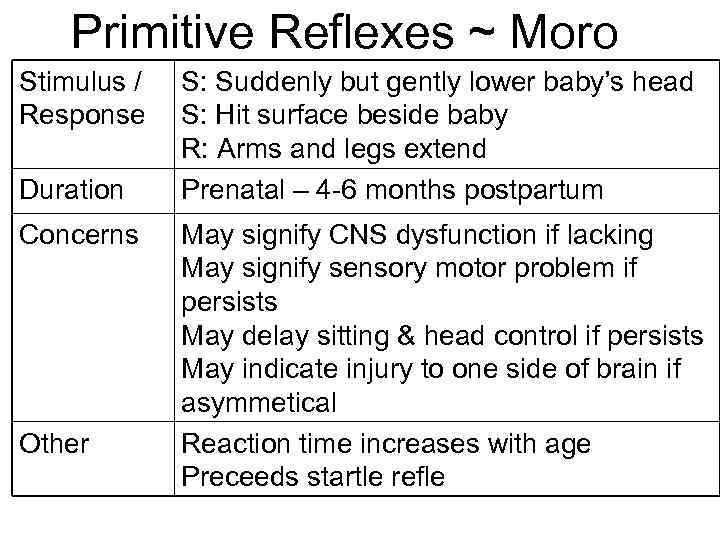 Primitive Reflexes ~ Moro Stimulus / Response Duration Concerns Other S: Suddenly but gently lower baby’s head S: Hit surface beside baby R: Arms and legs extend Prenatal – 4 -6 months postpartum May signify CNS dysfunction if lacking May signify sensory motor problem if persists May delay sitting & head control if persists May indicate injury to one side of brain if asymmetical Reaction time increases with age Preceeds startle refle
Primitive Reflexes ~ Moro Stimulus / Response Duration Concerns Other S: Suddenly but gently lower baby’s head S: Hit surface beside baby R: Arms and legs extend Prenatal – 4 -6 months postpartum May signify CNS dysfunction if lacking May signify sensory motor problem if persists May delay sitting & head control if persists May indicate injury to one side of brain if asymmetical Reaction time increases with age Preceeds startle refle
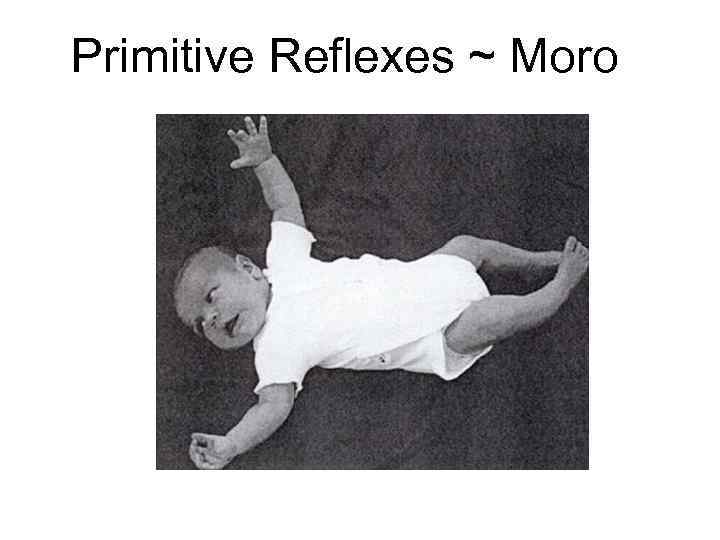 Primitive Reflexes ~ Moro
Primitive Reflexes ~ Moro
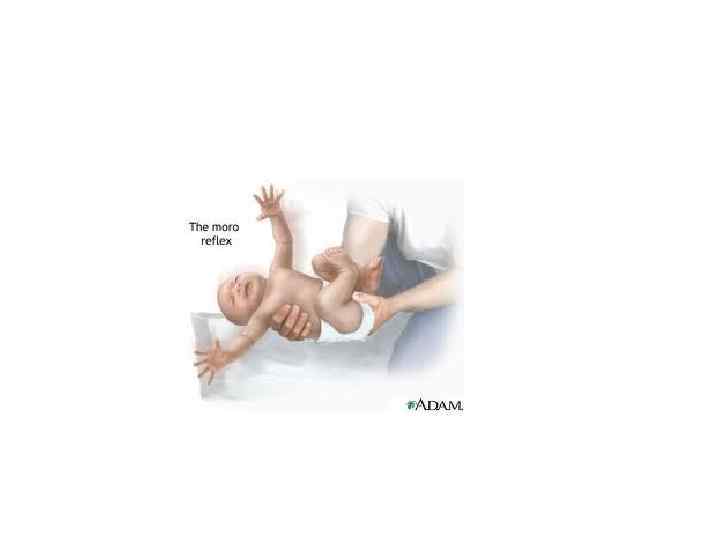
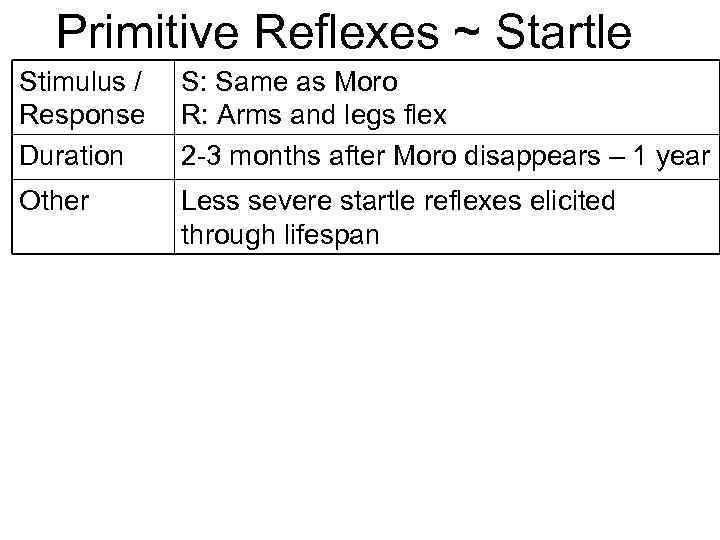 Primitive Reflexes ~ Startle Stimulus / Response Duration S: Same as Moro R: Arms and legs flex 2 -3 months after Moro disappears – 1 year Other Less severe startle reflexes elicited through lifespan
Primitive Reflexes ~ Startle Stimulus / Response Duration S: Same as Moro R: Arms and legs flex 2 -3 months after Moro disappears – 1 year Other Less severe startle reflexes elicited through lifespan
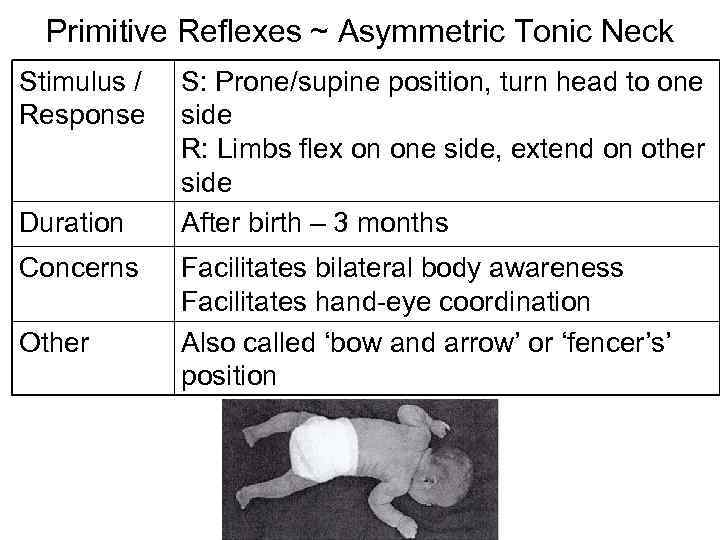 Primitive Reflexes ~ Asymmetric Tonic Neck Stimulus / Response Duration Concerns Other S: Prone/supine position, turn head to one side R: Limbs flex on one side, extend on other side After birth – 3 months Facilitates bilateral body awareness Facilitates hand-eye coordination Also called ‘bow and arrow’ or ‘fencer’s’ position
Primitive Reflexes ~ Asymmetric Tonic Neck Stimulus / Response Duration Concerns Other S: Prone/supine position, turn head to one side R: Limbs flex on one side, extend on other side After birth – 3 months Facilitates bilateral body awareness Facilitates hand-eye coordination Also called ‘bow and arrow’ or ‘fencer’s’ position
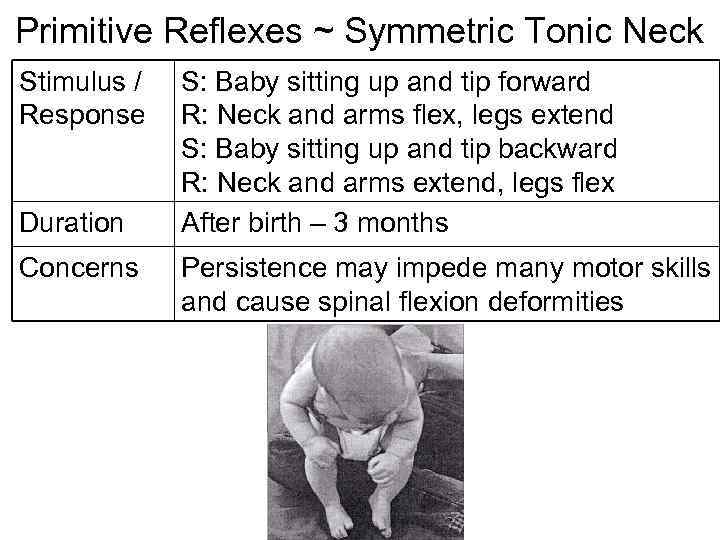 Primitive Reflexes ~ Symmetric Tonic Neck Stimulus / Response Duration Concerns S: Baby sitting up and tip forward R: Neck and arms flex, legs extend S: Baby sitting up and tip backward R: Neck and arms extend, legs flex After birth – 3 months Persistence may impede many motor skills and cause spinal flexion deformities
Primitive Reflexes ~ Symmetric Tonic Neck Stimulus / Response Duration Concerns S: Baby sitting up and tip forward R: Neck and arms flex, legs extend S: Baby sitting up and tip backward R: Neck and arms extend, legs flex After birth – 3 months Persistence may impede many motor skills and cause spinal flexion deformities
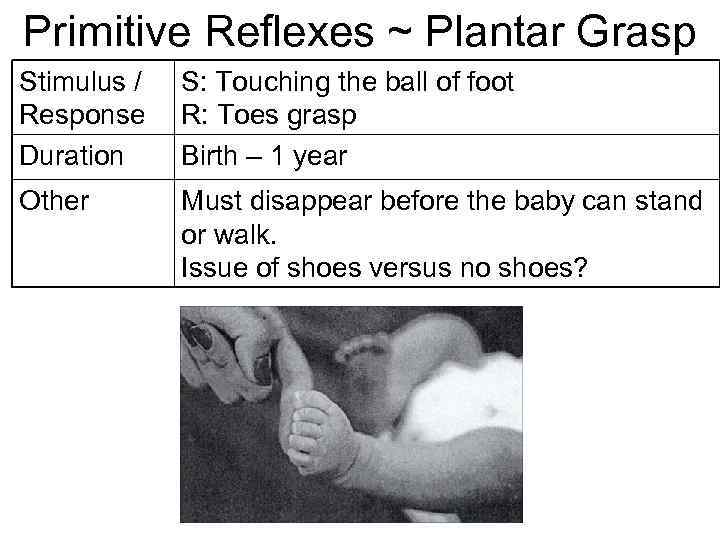 Primitive Reflexes ~ Plantar Grasp Stimulus / Response Duration S: Touching the ball of foot R: Toes grasp Birth – 1 year Other Must disappear before the baby can stand or walk. Issue of shoes versus no shoes?
Primitive Reflexes ~ Plantar Grasp Stimulus / Response Duration S: Touching the ball of foot R: Toes grasp Birth – 1 year Other Must disappear before the baby can stand or walk. Issue of shoes versus no shoes?
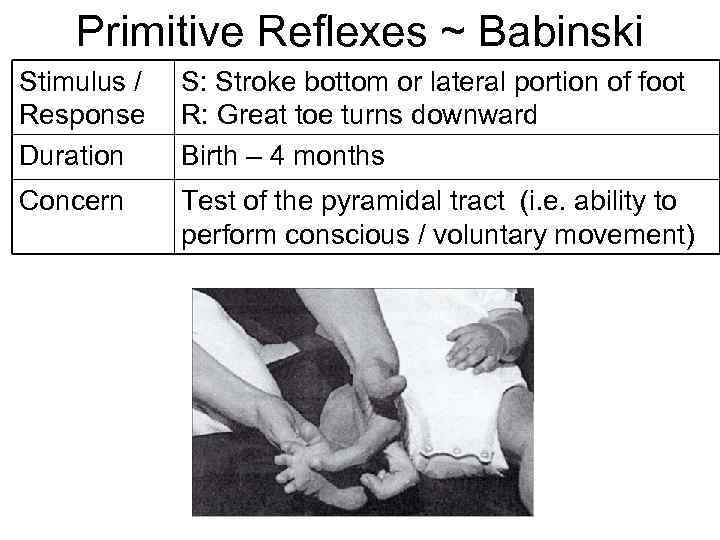 Primitive Reflexes ~ Babinski Stimulus / Response Duration S: Stroke bottom or lateral portion of foot R: Great toe turns downward Birth – 4 months Concern Test of the pyramidal tract (i. e. ability to perform conscious / voluntary movement)
Primitive Reflexes ~ Babinski Stimulus / Response Duration S: Stroke bottom or lateral portion of foot R: Great toe turns downward Birth – 4 months Concern Test of the pyramidal tract (i. e. ability to perform conscious / voluntary movement)
 Primitive Reflexes ~ Palmar Mandibular Stimulus / Response Duration S: Pressure to both palms or hair to hand R: Eyes close, mouth opens, and/or neck flexes (which tilts the head forward) Birth – 3 months Other Also called the Babkin reflex
Primitive Reflexes ~ Palmar Mandibular Stimulus / Response Duration S: Pressure to both palms or hair to hand R: Eyes close, mouth opens, and/or neck flexes (which tilts the head forward) Birth – 3 months Other Also called the Babkin reflex
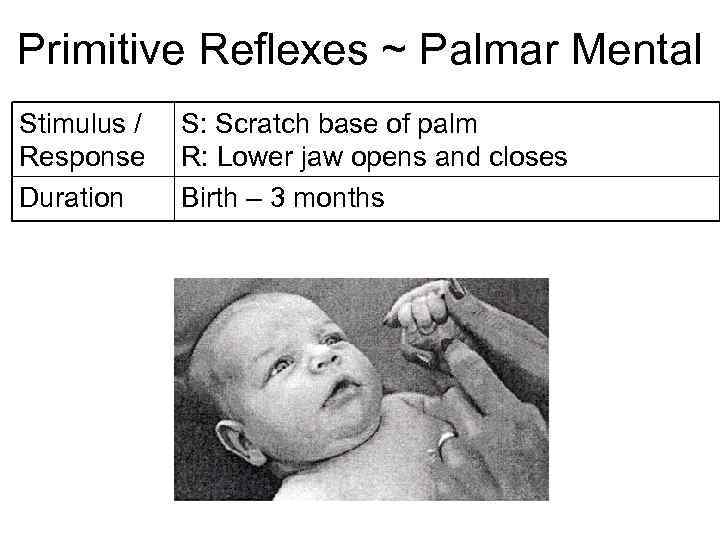 Primitive Reflexes ~ Palmar Mental Stimulus / Response Duration S: Scratch base of palm R: Lower jaw opens and closes Birth – 3 months
Primitive Reflexes ~ Palmar Mental Stimulus / Response Duration S: Scratch base of palm R: Lower jaw opens and closes Birth – 3 months
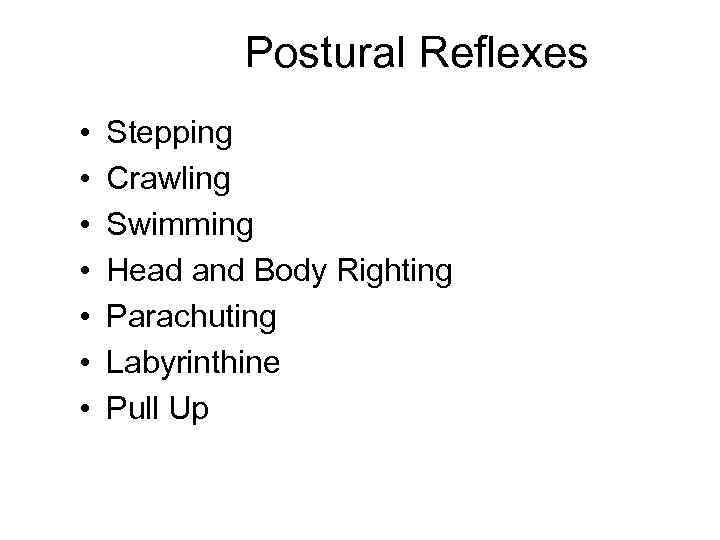 Postural Reflexes • • Stepping Crawling Swimming Head and Body Righting Parachuting Labyrinthine Pull Up
Postural Reflexes • • Stepping Crawling Swimming Head and Body Righting Parachuting Labyrinthine Pull Up
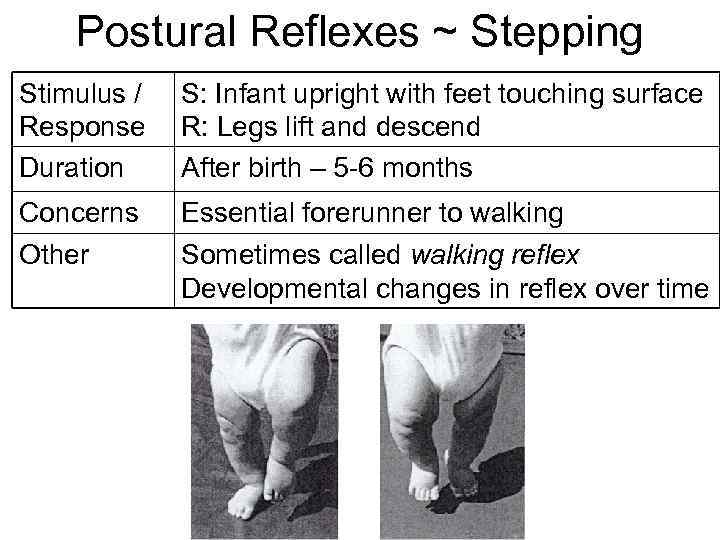 Postural Reflexes ~ Stepping Stimulus / Response Duration S: Infant upright with feet touching surface R: Legs lift and descend After birth – 5 -6 months Concerns Essential forerunner to walking Other Sometimes called walking reflex Developmental changes in reflex over time
Postural Reflexes ~ Stepping Stimulus / Response Duration S: Infant upright with feet touching surface R: Legs lift and descend After birth – 5 -6 months Concerns Essential forerunner to walking Other Sometimes called walking reflex Developmental changes in reflex over time
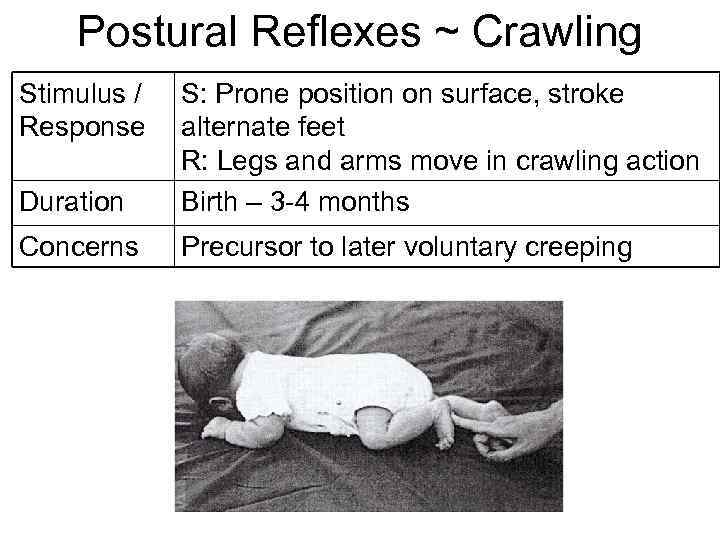 Postural Reflexes ~ Crawling Stimulus / Response Duration S: Prone position on surface, stroke alternate feet R: Legs and arms move in crawling action Birth – 3 -4 months Concerns Precursor to later voluntary creeping
Postural Reflexes ~ Crawling Stimulus / Response Duration S: Prone position on surface, stroke alternate feet R: Legs and arms move in crawling action Birth – 3 -4 months Concerns Precursor to later voluntary creeping
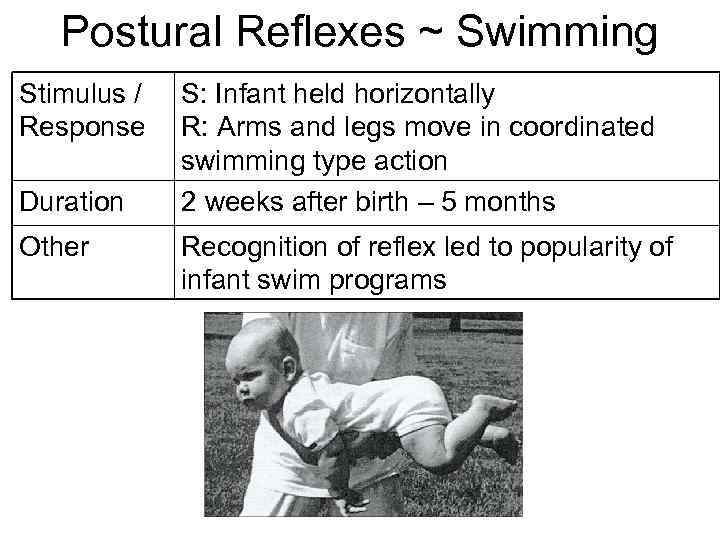 Postural Reflexes ~ Swimming Stimulus / Response Duration Other S: Infant held horizontally R: Arms and legs move in coordinated swimming type action 2 weeks after birth – 5 months Recognition of reflex led to popularity of infant swim programs
Postural Reflexes ~ Swimming Stimulus / Response Duration Other S: Infant held horizontally R: Arms and legs move in coordinated swimming type action 2 weeks after birth – 5 months Recognition of reflex led to popularity of infant swim programs
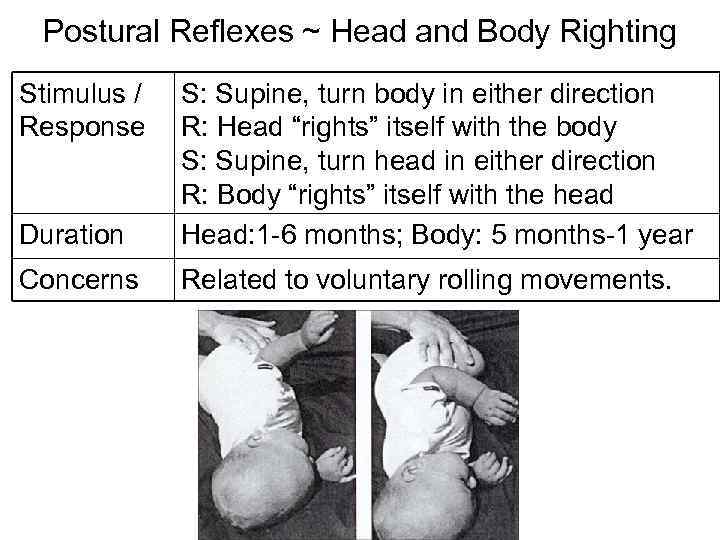 Postural Reflexes ~ Head and Body Righting Stimulus / Response Duration S: Supine, turn body in either direction R: Head “rights” itself with the body S: Supine, turn head in either direction R: Body “rights” itself with the head Head: 1 -6 months; Body: 5 months-1 year Concerns Related to voluntary rolling movements.
Postural Reflexes ~ Head and Body Righting Stimulus / Response Duration S: Supine, turn body in either direction R: Head “rights” itself with the body S: Supine, turn head in either direction R: Body “rights” itself with the head Head: 1 -6 months; Body: 5 months-1 year Concerns Related to voluntary rolling movements.
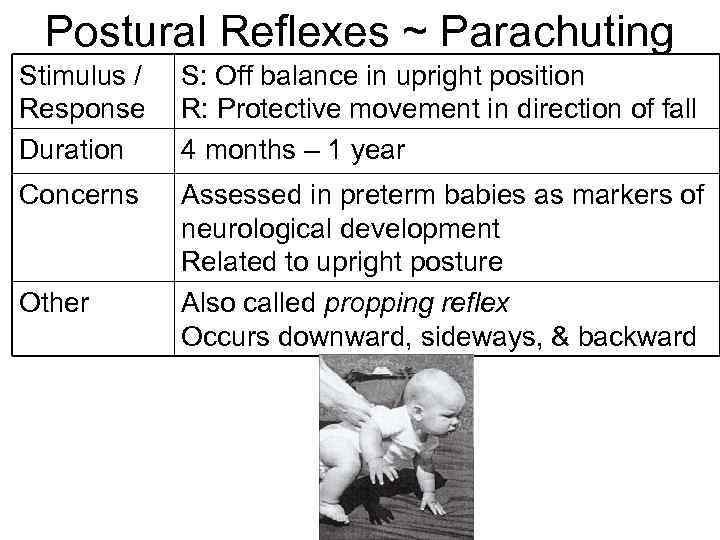 Postural Reflexes ~ Parachuting Stimulus / Response Duration S: Off balance in upright position R: Protective movement in direction of fall 4 months – 1 year Concerns Assessed in preterm babies as markers of neurological development Related to upright posture Also called propping reflex Occurs downward, sideways, & backward Other
Postural Reflexes ~ Parachuting Stimulus / Response Duration S: Off balance in upright position R: Protective movement in direction of fall 4 months – 1 year Concerns Assessed in preterm babies as markers of neurological development Related to upright posture Also called propping reflex Occurs downward, sideways, & backward Other
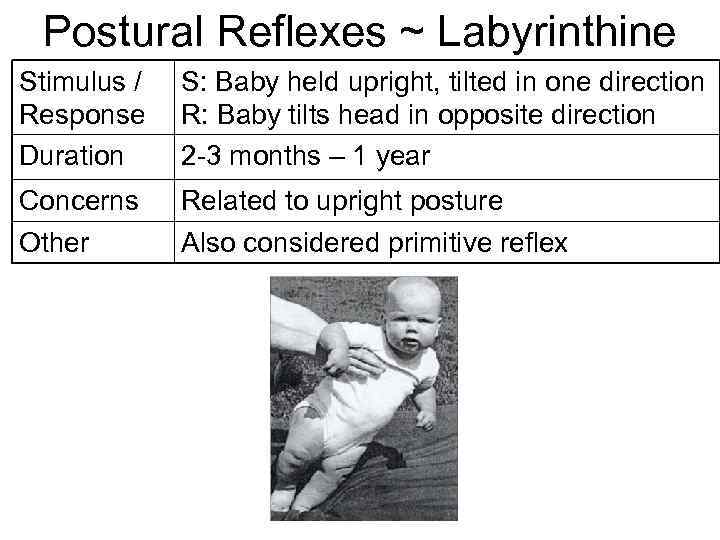 Postural Reflexes ~ Labyrinthine Stimulus / Response Duration S: Baby held upright, tilted in one direction R: Baby tilts head in opposite direction 2 -3 months – 1 year Concerns Related to upright posture Other Also considered primitive reflex
Postural Reflexes ~ Labyrinthine Stimulus / Response Duration S: Baby held upright, tilted in one direction R: Baby tilts head in opposite direction 2 -3 months – 1 year Concerns Related to upright posture Other Also considered primitive reflex
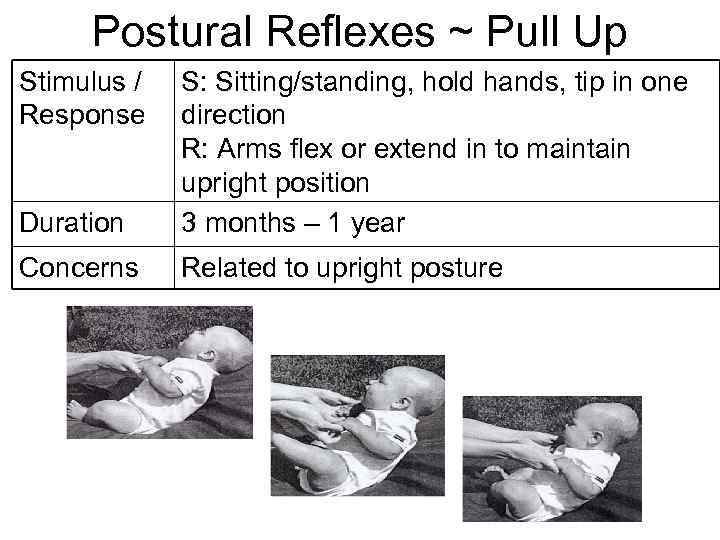 Postural Reflexes ~ Pull Up Stimulus / Response Duration S: Sitting/standing, hold hands, tip in one direction R: Arms flex or extend in to maintain upright position 3 months – 1 year Concerns Related to upright posture
Postural Reflexes ~ Pull Up Stimulus / Response Duration S: Sitting/standing, hold hands, tip in one direction R: Arms flex or extend in to maintain upright position 3 months – 1 year Concerns Related to upright posture
 In summary: Primitive Reflexes are present in the newborn infant These disappears with maturation of the CNS but reappears in degenerative diseases associated with loss of inhibitory activity in the brain or in frontal lobe and pyramidal tract lesions
In summary: Primitive Reflexes are present in the newborn infant These disappears with maturation of the CNS but reappears in degenerative diseases associated with loss of inhibitory activity in the brain or in frontal lobe and pyramidal tract lesions


